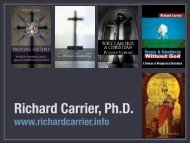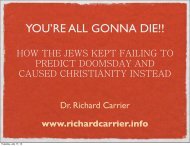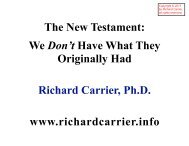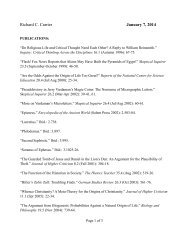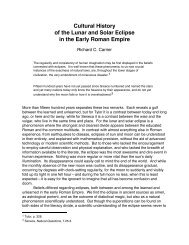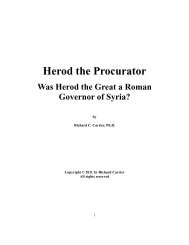“Bayes' Theorem for Beginners: Formal Logic and ... - Richard Carrier
“Bayes' Theorem for Beginners: Formal Logic and ... - Richard Carrier
“Bayes' Theorem for Beginners: Formal Logic and ... - Richard Carrier
You also want an ePaper? Increase the reach of your titles
YUMPU automatically turns print PDFs into web optimized ePapers that Google loves.
must thoroughly survey all relevant evidence <strong>and</strong> scholarship, no simple task) <strong>and</strong> often<br />
impossible to establish (since we know <strong>for</strong> a fact there was a great deal more diversity in<br />
Jewish beliefs <strong>and</strong> practice than we presently know any specifics of, <strong>and</strong> since the<br />
survival of sources is so spotty, no valid conclusion can be reached about what no Jews<br />
ever thought, said, or did).<br />
That invalidates the Minor Premise (“Saying x [Jesus addressing God as his<br />
Father] is dissimilar to the views of Judaism <strong>and</strong> to the views of the early church.”). But<br />
even the Major Premise here will be found indefensible on a complete nesting analysis.<br />
“If any saying x attributed to Jesus is dissimilar to the views of Judaism <strong>and</strong> to the views<br />
of the early church, then Jesus said x” assumes an invalid rule of inference: that only<br />
Jesus could innovate. But if Jesus could innovate a saying, then so could anyone,<br />
including an actual Gospel author (or other intermediary source)—note how Paul<br />
innovated a law-free Gentile mission, <strong>and</strong> if Paul could do that, so could anyone innovate<br />
anything, <strong>and</strong> we know too little about the many Christians <strong>and</strong> Jews who lived prior to<br />
the Gospels to rule any of them out, yet we would have to rule them all out in order to<br />
isolate Jesus as the only available innovator we can credit <strong>for</strong> the innovation.<br />
For instance, any saying (x) we think we can isolate as being unique to Jesus, may<br />
in fact be unique to Peter instead, who uniquely imagined or hallucinated or dreamed or<br />
invented Jesus saying (x). There is no more reason to assume the innovation was of Jesus’<br />
own making than of Peter’s (whether consciously, <strong>for</strong> a specific innovative purpose, or<br />
unconsciously, as a construct of what Peter took to be visions or revelations, but were<br />
actually the product of his subconscious creatively responding to the problems <strong>and</strong><br />
ambitions of his time). So how are we to tell the difference?<br />
EXAMPLE 2: Multiple Attestation : “If a tradition is independently attested in more than<br />
one source, then it is more likely to be authentic than a tradition attested only once.”<br />
Major Premise: If a tradition is independently attested in more than one source, then it is<br />
more likely to be authentic than a tradition attested only once.<br />
Minor Premise: Jesus healing the sick is independently attested in more than one source.<br />
Conclusion: There<strong>for</strong>e, Jesus healed the sick.<br />
RESULT: A nesting analysis will find flaws in both the major <strong>and</strong> minor premise here.<br />
As to the Minor Premise: Jesus healing the sick appears only in the Gospels <strong>and</strong><br />
later documents influenced by the Gospels, <strong>and</strong> not in any of the prior Epistles. The<br />
Synoptic <strong>and</strong> Apocryphal Gospels all show mutual dependence <strong>and</strong> there<strong>for</strong>e are not<br />
independent sources, <strong>and</strong> modern scholarship has established that the Gospel of John was<br />
probably influenced by that of Mark <strong>and</strong> Luke, <strong>and</strong> there<strong>for</strong>e there are no independent<br />
attestations of Jesus healing the sick: that concept appears only in documents ultimately<br />
derivative of the Gospel of Mark, which is the earliest mention of the tradition. There<strong>for</strong>e<br />
the criterion of multiple attestation might not apply.<br />
As to the Major Premise: it is well-documented that even a false claim can be<br />
multiply attested in independent sources (e.g. multiple independent sources attest to the<br />
labors of Hercules), <strong>and</strong> folklorists have documented that this can occur very rapidly<br />
(there is no actual limit to how rapidly multiple sources can trans<strong>for</strong>m <strong>and</strong> transmit the<br />
same story). There<strong>for</strong>e the rule of inference this criterion depends on is invalid. A more<br />
12



